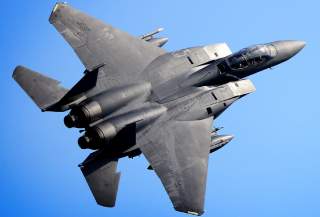Mayday, Mayday: Is the U.S. Military Old and Worn Out?
Simply put, the U.S. must get serious in how it assesses a return to “great power competition” and whether it is willing to invest in its military at a level that reflects the importance of America’s interests in alliance relationships, trading partners, and access to markets. Our competitors (and our friends, too) can count.
Who doesn’t want a simpler, less threatening world, one with more commerce and prosperity, and much less violence?
But we must live in the world as it is, not as it should be. History shows that competing powers consistently emerge and that the U.S. must be able to defend its interests in more than one region at a time.
There are also times when lesser powers or non-state actors, like well-organized terrorist organizations or criminal cartels, arise. If sufficiently motivated and equipped, they, too, can destabilize areas important to America’s security, economic and diplomatic interests.
In all such cases, the United States must be able to respond on its own terms – preferably with allies or partners, but unilaterally if necessary. Without this ability, U.S. national security becomes hostage to the good graces of others.
It is essential, therefore, that our leaders plan for, fund, and consistently sustain U.S. military capabilities at levels commensurate with our global interests. Frustratingly, America has not been serious in this way for a very long time.
Throughout the Cold War, the U.S. committed 20-25 percent of the federal budget to defense—the equivalent of five to six percent of GDP. It allowed us to lead a free and prosperous West to victory over an authoritarian and repressive Soviet bloc.
Today, defense accounts for only 15 percent of federal outlays and a mere 3.2 percent of GDP. If this were enough to sustain the military capacity, capability, and readiness needed to protect vital U.S. interests, then nothing more need be spent. But it is not enough and has not been enough since the end of the Cold War.
At present, the average age of Air Force fighter aircraft is 28 years. The F-15C, which constitutes the bulk of air superiority aircraft, averages more than 35 years old. KC-135s, which account for nearly 90 percent of the Air Force’s tanker fleet are 57 years old, on average.
Our navy is long in the tooth, as well. Fifty-seven percent of its ships—including all cruisers and ballistic- and guided-missile nuclear submarines—are at least 20 years old. or more, Eighty percent of our aircraft carriers, 41 of 49 fast attack nuclear submarines, and a majority of our destroyers are just as old.
Near the end of the Cold War, the Navy had at least 550 ships. Today, its battle force numbers 290 ships—only 82 percent of what the Navy says is the minimum needed to meet mission requirements. And that may be overly optimistic. A number of major studies suggest that it actually has only 73% of the fleet needed.)In comparison, China alone already has 300 ships and will possess 350 within five years.
As for the Army, let’s keep it simple: in 1989, it boasted an active-duty force of 770,000 soldiers; today that number is less than 480,000.
These are but a few examples of how much our military has aged and withered. Yet, the planet’s oceans, air spaces, and landmasses have not gotten any smaller, nor does the world have a shortage of threatening regimes and conflict-prone regions.
Today, Russia has risen from its proverbial ashes, and China has figured out how to leverage authoritarian capitalism. Russia has exploited its muscular presence in Europe to coerce and intimidate its neighbors, and China has lured suitors with the lucrative potential of its 1.3 billion citizens. Russia has invaded and/or seized portions of Georgia and Ukraine, executed cyber-attacks against NATO members, salvaged Bashar al-Assad’s regime in Syria, and sought every opportunity to disrupt representative democracies and free-market capitalism. China has successfully undertaken an historic, strategic shift in its military posture, from an inward-looking army focused on securing the communist party’s hold on power to an outward-looking, power-projecting military that prioritizes naval, air, and missile forces. This alarming development worries both China’s near neighbors and major economic powers elsewhere. The U.S. is particularly concerned, as it suffers the most from Beijing’s serial theft of intellectual property, barriers to fair competition in China’s domestic market, and manipulation of market dynamics by various forms of government intervention.
For nearly 30 years, America’s military has declined in capacity, modernity (good equipment being prematurely aged and not replaced as quickly as it is retired), and overall readiness, at scale, relevant to large-scale conventional war. The 60-80 ships the U.S. Navy routinely deploys to Indo-Pacific waters would be hard-pressed to compete with China’s navy of 500 ships, augmented by land-based aircraft and missiles able to target ships at sea. Similar conditions exist with respect to U.S. land and air power in Europe.
Simply put, the U.S. must get serious in how it assesses a return to “great power competition” and whether it is willing to invest in its military at a level that reflects the importance of America’s interests in alliance relationships, trading partners, and access to markets. Our competitors (and our friends, too) can count. They track not only our defense spending but the rate at which we replace old worn-out equipment with new.
Partisan political fights that delay or hold-hostage passage of defense budgets aren’t helpful. Neither is political messaging that proclaims our overworked military has been “fixed,” as if we can put paid to its renovation and move on to other things.
Let’s get serious about our military so that others take it seriously, too. That is the surest way to achieve deterrence and to prevent wars that no one actually wants to fight.
Dakota L. Wood is The Heritage Foundation’s senior research fellow for defense programs and editor of the think tank’s 2020 Index of U.S. Military Strength.

